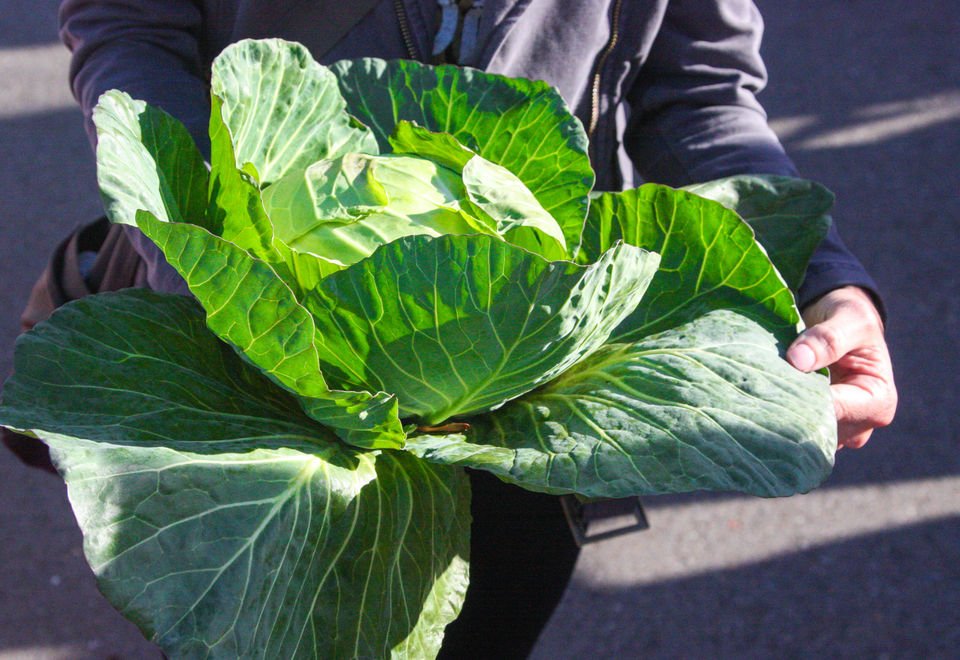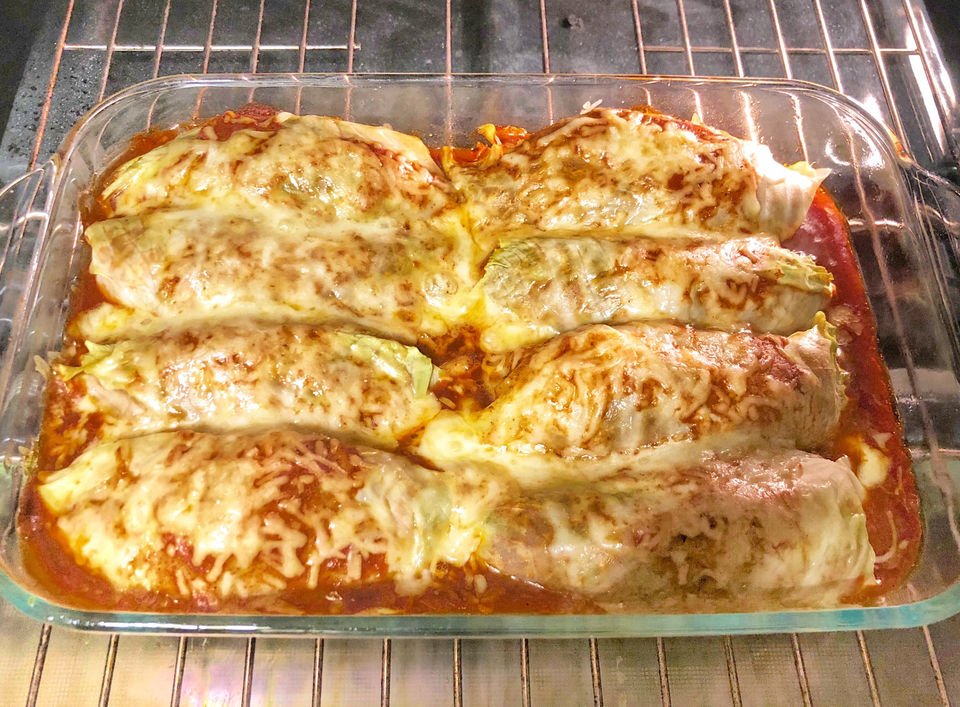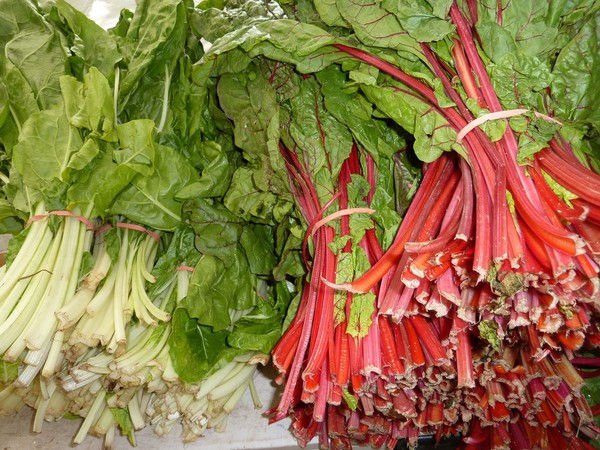Wrap up in leafy winter greens with these warming recipes
Cabbage. Photo by Emily Eickhoff
You’re chilled to the bone, so maybe the first dish that leaps to mind in winter isn’t one made with leafy greens.
This time of year, however, the dark leaves of kale, big bunches of mustard greens and giant heads of cabbage are plentiful and thus less expensive.
The greens make great partners in easy-to-prepare lower-carb, lower-calorie versions of hearty winter favorites, such as lasagna and enchiladas (see a recipe below): Simply swap leaves for noodles and tortillas.
Drop greens into soups and stir-fries for added fiber, flavor and nutrients. All leafy greens have some nutritional benefit and all are low in calories, carbs and sugars. Most are sound sources of vitamins A, C, K and folate.
Shopping for greens
Whether you’re at the farmers market or grocery store, you can find winter greens far beyond just kale: Swiss chard, rainbow chard, mustard greens, turnip greens, beet greens, carrot greens, bok choy, red leaf lettuce and purple cabbage (These last two aren’t technically “greens,” but they’re in the same family). Lettuces are plentiful this time of year as well, so pair hot dishes with a side salad of fresh-from-the-market winter produce.
Storing greens
Store unwashed greens in the fridge for up to four days. Separating the stems from the leaves may help to give a few extra days. Reserve and freeze stems for use in flavoring homemade stocks and soup broths.
Prepping greens
Rinse and pat greens dry, but don’t obsess over getting every last drop. Winter greens are thicker and heartier, so unlike more delicate greens, the extra moisture won’t turn them into mush.
Neutralizing greens
Winter greens are usually more bitter than summer greens, which makes them less popular in some households. Adding a touch of acid (think apple cider vinegar or lemon juice) can neutralize this bitterness. Same goes for a touch of sweet. Adding a teaspoon of sugar or honey to a giant pot of greens is fine; it’s literally a drop in the bucket. A touch of creaminess, like a sprinkling of cheese or a dollop of 2 percent plain Greek yogurt, softens the flavor and makes a creamier side dish.
Grilling greens
Use the grill outdoors or a cast iron skillet inside. Coat the pan or grill with olive oil or spritz with cooking spray, and grill hearty greens, such as kale, for four to five minutes on each side until they are ever so slightly charred and lightly wilted.
Stuff or wrap greens
Oversized leaves (think green or purple cabbage, collards or mustard greens) can be stuffed with shrimp, lean ground beef or grain mix with vegetables, or used in place of tortillas and pasta for grain-free, gluten-free, low-carb dishes like burritos and manicotti.
One note: Taste the greens raw. If winter greens are a bit tough, remove the stalks, reserving them for use in flavoring stocks, and give the leaves a quick, 2-minute boil to soften. Allow greens to cool and pat them dry. Store leaves flat and place in loosely covered container in refrigerator for up to three days.
Puréeing greens
Make countless variations of winter green soup by sautéing three or four bundles of greens with olive oil, onion and garlic, adding four cups of low-sodium vegetable broth or stock and cooking till greens are tender.
Then, puree greens in the food processor or with stick blender until smooth. Add a splash of lemon juice and any herbs or spices for a vegan soup that uses every last bit of those veggies, including the tougher stems and stalks.
Enchiladas wrapped in cabbage leaves. (Photo by Diedra Dias)
•
A friend of mine adapted this recipe from delish.com for an easy weeknight dinner, simply replacing the traditional carby wrap with cabbage leaves.
You won’t use the whole head of cabbage when making this, so shred the rest and make a light coleslaw for later.
If watching sodium, check the ingredient list on the enchilada sauce that you purchase.
Low Carb Enchiladas
Makes 4 servings
1 head green cabbage
1 tablespoon olive oil
1 large onion, chopped
1 red bell pepper, chopped
1 dash sea salt
2 cloves garlic, minced
2 teaspoons ground cumin
2 teaspoons chili powder
3 cups cooked chicken, shredded
1 cup red enchilada sauce, divided
1/4 cup fresh cilantro, divided
1/3 cup shredded cheddar
1/2 cup shredded Monterrey Jack
1/4 cup Greek yogurt, 2 percent fat, for garnish
Preheat oven to 350 degrees.
In large pot, boil four cups water. Using tongs, dip each cabbage leaf in water for 30 seconds and place on a paper towel-lined plate to dry.
In large skillet over medium heat, heat oil. Add onion and bell pepper and season with salt. Cook until soft, 5 minutes, then stir in garlic, cumin and chili powder. Add shredded chicken and 3/4 cup enchilada sauce. Stir until combined. Turn off heat and stir in half of cilantro.
Place heaping spoonful of chicken mixture into the center of each cabbage leaf. Fold short sides of cabbage leaf in first, then roll into a cylinder like a burrito. Repeat until chicken mixture is gone.
Place cabbage rolls in a greased baking dish. Spoon remaining 1/4 cup enchilada sauce over rolls and sprinkle with both cheeses.
Bake until warmed through and cheese is melted, about 20 minutes.
To serve, plate enchiladas and top with dollop of Greek yogurt and a bit of remaining cilantro.
Per serving: 320 calories, 18 grams fat, 7 grams saturated fat, 35 mg sodium, 26 grams carbohydrates, 19 grams NET carb, 7 grams fiber, 11 sugar, 19 grams protein.
Quick, easy greens. Photo from chef Kenneth Temple
Want more greens recipes, here are a few
Chef Kenneth Temple’s recipe also works with mustard and turnip greens. This dish takes about 15 minutes to make. It’s a variation on the low and slow method. This recipe and the other two below are from his “Southern Creole” cookbook. Find the recipe here.
Many Greens Soup. Photo by Oliver Barth, 2016 Sterling Publishing
Do you ever buy bunches of greens — kale, arugula, spinach — and then find yourself at a loss as to what to do with them? They are starting to wilt and whatever plans you had for them have somehow not come together. To avoid waste, consider two solutions: Make a soup or make a smoothie. Find this Many Greens Soup recipe here.
Red and green chart. NOLA.com | The Times-Picayune
Most recipes call for some cooking to reduce bitterness, as well as to soften the leaves and stems to make them edible and more palatable. Wilted, blanched, sauteed, braised, or even pureed, these greens add great balance and depth to any dish and pair especially well with garlic, lemon, and olive oil.
Here’s a guide to cooking greens at home from Epicurious.com.





